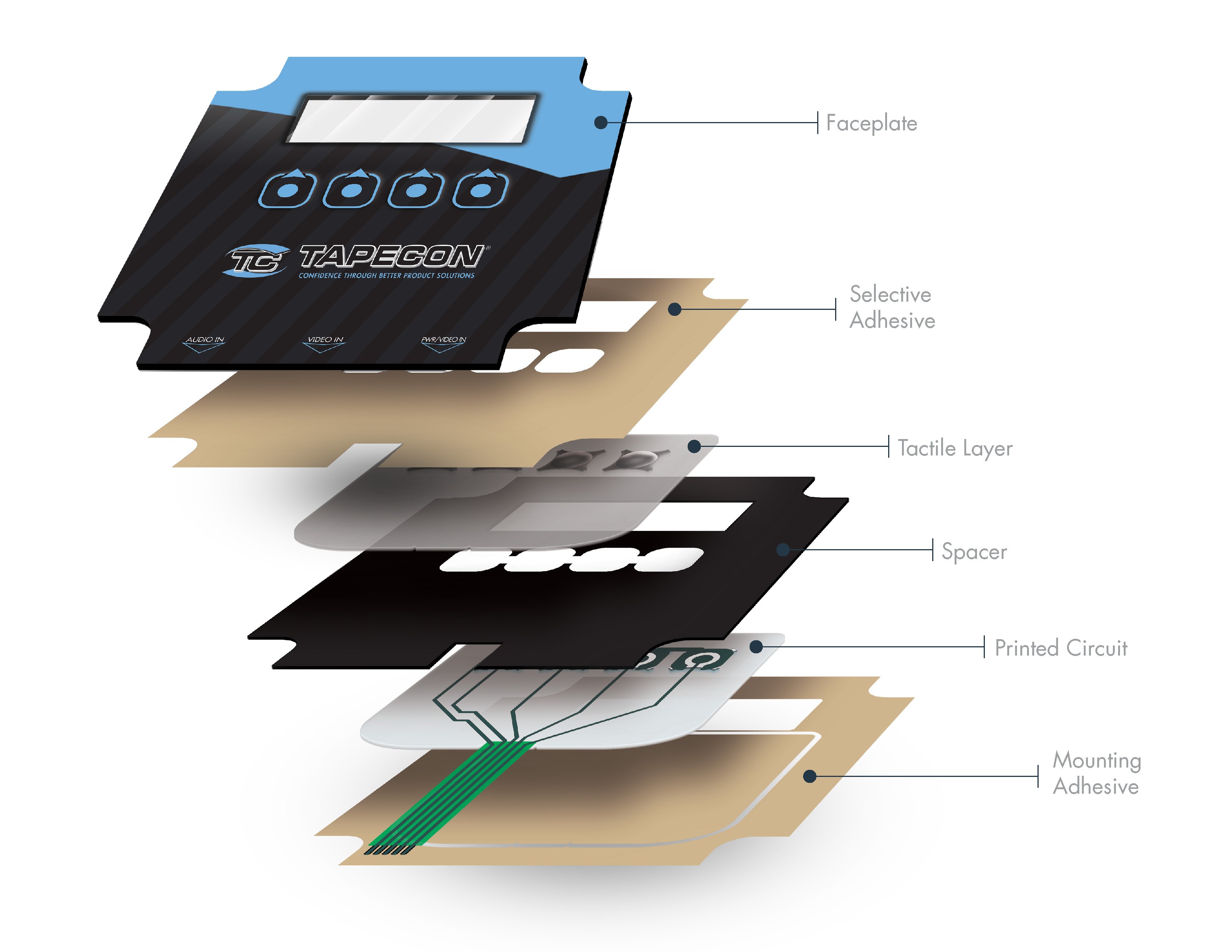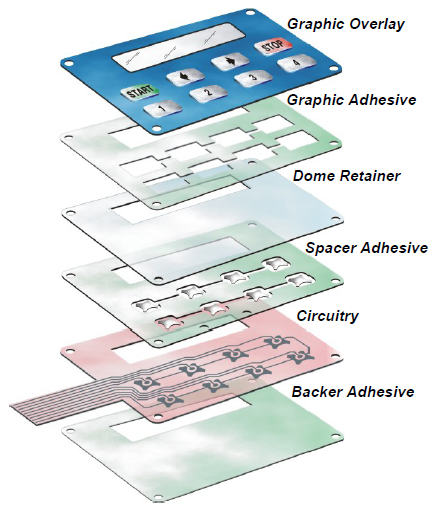Membrane Layer Switch Modern Technology: The Key to Dependable and Economical User Interfaces
Membrane layer button innovation has actually become an essential part in the layout of interface, giving both reliability and cost-effectiveness throughout a diverse range of applications. Its durable construction makes certain resistance to environmental challenges, while the adaptability in layout permits tailored remedies that fulfill particular market needs. As we discover the diverse benefits of membrane buttons, their capacity for innovation questions about future applications and developing fads. What does the following chapter hold for this innovation in an increasingly digital landscape?
Understanding Membrane Layer Switch Over Technology
Membrane switch technology is an extensively used user interface solution in numerous electronic tools, supplying a smooth blend of performance and design. This modern technology incorporates multiple layers of materials, generally consisting of a graphic overlay, spacer layer, and a circuit layer. The graphic overlay presents the interface components, while the spacer layer divides the circuit layer from the overlay till an individual activates a button.
When pressure is related to the overlay, the circuit layer finishes the electric circuit, sending a signal to the tool. This system allows for various setups, consisting of responsive responses and backlighting options, improving user communication. Membrane layer switches are usually produced utilizing resilient materials such as polyester or polycarbonate, making sure long life and resistance to ecological aspects like moisture and dirt.
The convenience of membrane layer changes allows their application in diverse markets, consisting of clinical tools, customer electronics, and commercial controls. Their compact layout enables for assimilation right into space-constrained settings, providing a reliable individual interface without endangering aesthetic appeal. Recognizing the intricacies of membrane layer button modern technology is necessary for producers and designers seeking to create dependable and efficient human-machine interfaces.
Key Benefits of Membrane Layer Buttons
While various interface options exist, membrane switches over offer distinct advantages that make them a preferred selection in many applications. Among the key advantages is their toughness; membrane switches are made to hold up against rough environmental problems, consisting of dampness, dirt, and temperature level variations, making sure resilient efficiency. This resilience significantly minimizes the demand for constant replacements, consequently reducing overall upkeep expenses.

In addition, membrane layer buttons are light-weight and portable, making them suitable for applications where space is restricted. Their inconspicuous design adds to a streamlined look without jeopardizing functionality.
Cost-effectiveness is also a noteworthy benefit, as the manufacturing process for membrane layer switches over often tends to be less costly compared to conventional mechanical switches. This cost, incorporated with their reliability and convenience of setup, positions membrane layer switches as a practical option for a vast array of markets seeking effective and reliable interface.
Applications Throughout Various Industries
Exactly how do membrane layer buttons adjust to the diverse demands of different sectors? Membrane button modern technology is progressively acknowledged for its flexibility, making it suitable for a large range of applications throughout numerous fields.
In customer electronic devices, membrane layer switches provide a compact service for push-button controls and home appliances, enhancing customer experience with instinctive layout. Furthermore, the industrial sector leverages membrane buttons for equipment control panels, gaining from their resistance to rough environments, such as wetness and dust.
Army and directory aerospace applications additionally make use of membrane switches for their integrity and ability to hold up against extreme problems, making sure operational efficiency in important scenarios. The food and drink sector embraces these buttons for automated systems, where hygiene and simplicity of operation are paramount (membrane switch). Ultimately, membrane buttons are tailored to fulfill the distinct demands of each industry, showing their important duty in modern technology interfaces
Layout and Modification Alternatives

In the world of membrane switch innovation, design and modification alternatives play a crucial function in boosting capability and customer communication. These buttons can be tailored to satisfy specific functional demands and aesthetic choices, making them functional components in various applications.
Among the key personalization options is the design of the switch itself, which can be designed to accommodate one-of-a-kind customer interfaces and ergonomic considerations. By readjusting the shape, dimension, and setup of switches, suppliers can create user-friendly styles that help with convenience of use. In addition, the incorporation of various colors and visuals overlays enables branding and enhanced exposure, making certain that individuals can quickly determine functions.
Additionally, membrane switches can be crafted with numerous tactile responses systems, such as raised buttons or distinct clicks, to enhance the customer experience. Different products can also be chosen for toughness and environmental resistance, dealing with factors such as wetness, temperature changes, and chemical exposure.
Inevitably, the considerable layout and customization alternatives readily available in membrane button innovation encourage companies to produce about his tailored solutions that not only fulfill practical requirements however also line up with their branding and operational requirements.

Future Patterns in Membrane Switches
As membrane layer switch modern technology remains to progress, future trends are progressively concentrated on improving customer experience and incorporating advanced capabilities. One substantial pattern is the integration of touch-sensitive and capacitive technologies right into standard membrane switches. This growth enables for even more user-friendly individual interfaces, supplying tactile feedback while maintaining a sleek style.
An additional emerging trend is using eco-friendly materials, driven by the expanding demand for sustainable production techniques. Makers are looking for to minimize their carbon footprint by utilizing recyclable substratums and low-impact inks, lining up with international sustainability goals.
Moreover, the Go Here increase of the Net of Points (IoT) is prompting the unification of smart functions right into membrane switches. Enhanced connectivity alternatives will certainly make it possible for gadgets to connect with each other, enabling smooth integration right into broader systems.
Furthermore, developments in printing technologies, such as digital printing, are enabling for higher design flexibility and customization. This enables manufacturers to generate elaborate designs and vivid colors cost-effectively.

Verdict
In verdict, membrane layer switch innovation represents an important development in individual interface layout, providing significant benefits in longevity, customization, and cost-effectiveness. Its extensive applicability across diverse markets underscores its importance in contemporary technology. As innovations proceed to emerge, particularly in touch-sensitive interfaces and sustainable products, the capacity for membrane layer switches to enhance individual experience and functionality remains appealing. Proceeded expedition of this innovation will likely generate even more enhancements and widen its scope in future applications.